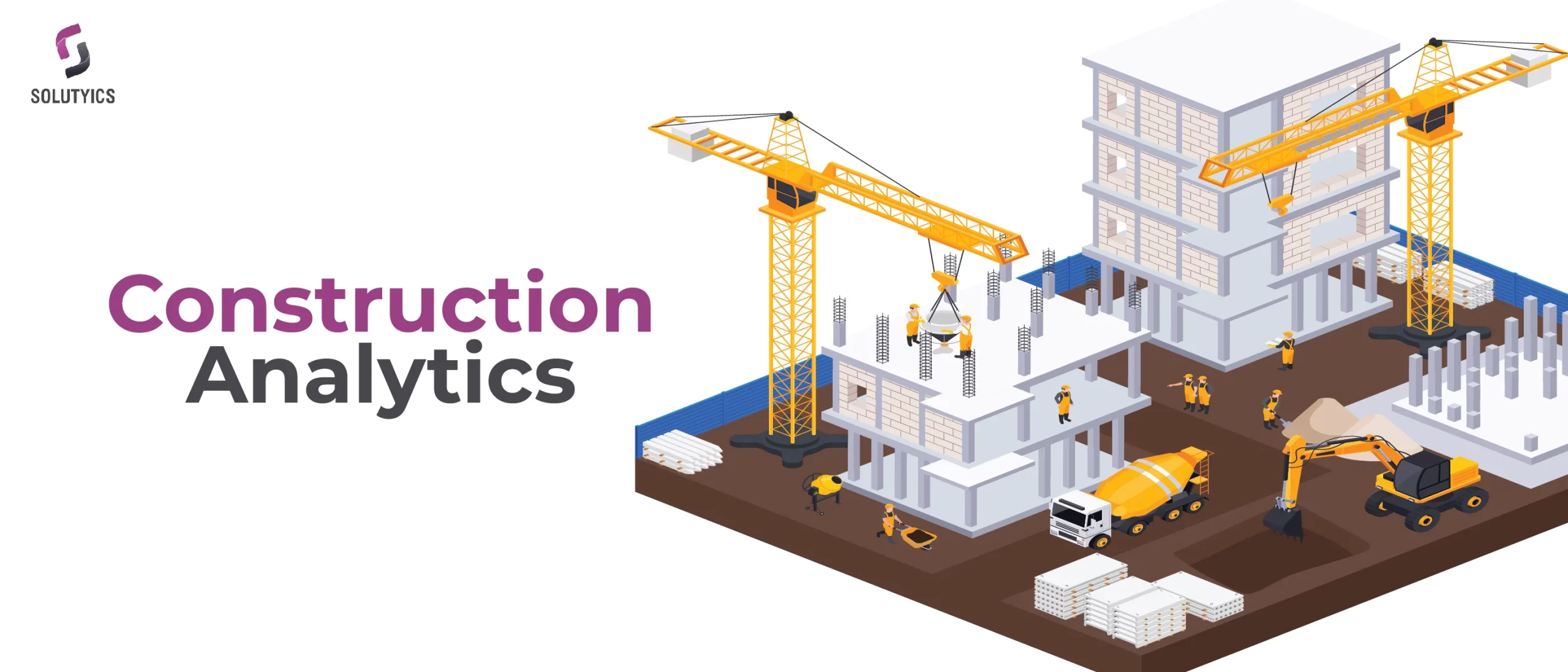
Construction analytics involves utilizing data analysis and business intelligence tools to extract valuable insights from various data sources within the construction industry. This process includes collecting, processing, and analyzing data related to construction projects. The goal is to enhance decision-making processes, optimize project performance, and improve overall efficiency in construction operations.
Construction analytics may involve tasks such as data collection from project management software and IoT devices, data processing to ensure accuracy, data analysis to identify patterns and trends, visualization of insights through charts and dashboards, predictive analytics for forecasting, resource optimization, risk management, and ongoing monitoring of key performance indicators. This approach enables stakeholders in the construction industry to make informed decisions, mitigate risks, and optimize resource allocation for better project outcomes.

How it evolved the Construction industry:
Construction analytics has brought about significant changes in the construction industry by introducing data-driven insights and optimization strategies. Here are some ways in which construction analytics has impacted the industry:
1. Improved Decision-Making:
Construction analytics enables stakeholders to make more informed decisions by providing real-time insights into project performance, resource allocation, and potential risks. This leads to better decision-making at every stage of a construction project.
2. Enhanced Efficiency:
By analyzing data related to resource utilization, project timelines, and performance metrics, construction analytics helps identify inefficiencies and areas for improvement. This leads to streamlined processes, reduced delays, and increased overall efficiency in construction operations.
3. Cost Savings:
The ability to analyze historical data and predict future outcomes allows construction professionals to optimize resource allocation and budgeting. This results in cost savings by minimizing waste, avoiding unnecessary expenses, and improving overall financial management.
4. Risk Mitigation:
Construction analytics facilitates proactive risk management by identifying potential issues early in the project lifecycle. This allows for timely intervention and mitigation strategies, reducing the likelihood of costly delays and disruptions.
5. Resource Optimization:
Construction analytics helps optimize the allocation of resources such as labor, equipment, and materials. This ensures that resources are used efficiently, reducing downtime and improving overall project productivity.
6. Improved Project Planning:
Through predictive analytics, construction professionals can forecast project timelines more accurately. This aids in better project planning, resource scheduling, and coordination, resulting in smoother project execution.
7. Enhanced Collaboration:
Analytics tools often provide collaborative platforms where stakeholders can share and access real-time project data. This fosters better communication and collaboration among project teams, subcontractors, and other stakeholders.
8. Technology Integration:
Construction analytics often involves the integration of emerging technologies such as IoT devices, sensors, and drones. This integration enhances data collection capabilities, providing a more comprehensive and accurate view of project conditions.
9. Client Satisfaction:
With better project planning, reduced delays, and improved overall efficiency, construction analytics contributes to higher client satisfaction. Meeting or exceeding project expectations is more achievable when informed decisions are made based on data insights.
10. Adoption of Digital Technologies:
The implementation of construction analytics often goes hand-in-hand with the adoption of digital technologies, such as Building Information Modeling (BIM) and project management software. This digital transformation enhances collaboration, data accuracy, and project coordination.
Software tools for applying Construction Analytics:
Several software tools are available for applying construction analytics, ranging from business intelligence platforms to specialized construction management software. The choice of software depends on the specific needs and objectives of the construction firm. Here are some popular software categories and examples:
Business Intelligence Platforms:
1. Tableau:
A powerful data visualization tool that allows users to create interactive and shareable dashboards, making it easy to analyze and interpret construction data.
2. Power BI (Microsoft):
Microsoft’s business analytics service for creating interactive reports and dashboards, integrating with various data sources to provide real-time insights.
3. QlikView/Qlik Sense:
Qlik’s data visualization and business intelligence tools that enable users to explore and visualize construction data for better decision-making.
Construction Management Software:
1. Procore: A cloud-based construction management platform that integrates project management, quality management, and construction analytics to enhance collaboration and efficiency.
2. PlanGrid (Autodesk): A construction productivity software that allows teams to collaborate on project plans, track progress, and leverage analytics for performance insights.
3. Viewpoint Vista: A construction management software suite that includes features for project management, financials, and analytics to streamline construction operations.
Predictive Analytics Tools:
1. IBM SPSS Statistics: A statistical software used for predictive analytics, data analysis, and reporting to make data-driven decisions in construction projects.
2. RapidMiner: An open-source data science platform that includes predictive analytics, machine learning, and advanced analytics capabilities for construction data.
Building Information Modeling (BIM) Software:
1. Autodesk Revit: A BIM software that facilitates 3D modeling and collaboration, integrating with analytics tools for better project insights.
2. Trimble Tekla Structures: BIM software designed for construction, providing detailed models and analytics for structural planning and design.
Project Management Software:
1. Asana: A project management tool that enables teams to plan, track, and manage construction projects, integrating with analytics tools for performance monitoring.
2. Smartsheet: A collaboration and work management platform that includes project management features and integrates with business intelligence tools for analytics.
Construction ERP Software:
1. Sage 300 Construction and Real Estate: An enterprise resource planning (ERP) solution tailored for the construction industry, integrating financials, project management, and analytics.
2. Viewpoint Spectrum: A construction-specific ERP solution that includes features for project management, accounting, and analytics.
When implementing construction analytics, it’s essential to choose software that aligns with the firm’s specific goals, integrates seamlessly with existing systems, and provides the necessary features for data collection, analysis, and visualization. Additionally, considering scalability and user-friendliness is crucial for long-term succes.
Real-world examples:
Bechtel:
Implementation: Bechtel, one of the largest engineering, construction, and project management companies globally, has embraced data analytics to enhance project performance.
Benefits: By leveraging analytics tools, Bechtel aims to improve project efficiency, reduce costs, and enhance collaboration. The company uses data to predict and address potential issues before they impact project timelines.
Skanska:
Implementation: Skanska, a multinational construction and development company, has invested in digital technologies and analytics to improve project outcomes.
Benefits: Skanska uses analytics for real-time project monitoring, resource optimization, and risk management. This approach has helped the company identify opportunities for efficiency gains and cost savings, contributing to successful project delivery.
Clark Construction:
Implementation: Clark Construction, a U.S.-based construction company, has integrated construction analytics into its project management processes.
Benefits: Clark Construction uses analytics to track project progress, manage resources effectively, and enhance communication among project teams. This has led to improved decision-making and overall project efficiency.
Turner Construction:
Implementation: Turner Construction, a leading construction services company, has embraced technology and analytics to drive innovation in the construction industry.
Benefits: Turner Construction utilizes analytics for project planning, risk management, and quality control. The company has experienced improved collaboration, reduced project delays, and increased client satisfaction through data-driven decision-making.
Mortenson Construction:
Implementation: Mortenson Construction, a U.S.-based construction firm, has incorporated analytics into its project management processes.
Benefits: Mortenson Construction leverages analytics to optimize resource allocation, monitor project performance, and enhance safety protocols. This data-driven approach contributes to successful project outcomes and client satisfaction.
These examples highlight how construction firms are applying analytics to various aspects of their projects, including planning, resource management, risk mitigation, and overall project efficiency. By doing so, these companies aim to stay competitive, deliver projects more effectively, and navigate the complexities of the construction industry.

Conclusion:
In conclusion, the evolution of construction analytics has significantly transformed the construction industry by introducing data-driven decision-making and optimization. Firms that have embraced construction analytics, such as Bechtel, Skanska, Clark Construction, Turner Construction, and Mortenson Construction, have experienced improved project efficiency, cost savings, enhanced risk mitigation, and increased client satisfaction. The adoption of software tools across various categories, from business intelligence platforms to predictive analytics tools, has played a crucial role in achieving these benefits. Overall, construction analytics continues to shape the industry by providing actionable insights and promoting a more efficient and collaborative approach to construction project management.
Faqs
Q1: What tasks are involved in construction analytics?
Construction analytics tasks include data collection from project management software and IoT devices, data processing for accuracy, data analysis to identify patterns and trends, visualization through charts and dashboards, predictive analytics for forecasting, resource optimization, risk management, and ongoing monitoring of key performance indicators.
Q2: What are some real-world examples of firms implementing construction analytics?
Several firms, including Bechtel, Skanska, Clark Construction, Turner Construction, and Mortenson Construction, have implemented construction analytics. They have experienced benefits such as improved project efficiency, cost savings, enhanced risk mitigation, and increased client satisfaction.
Q3: What software tools are available for applying construction analytics?
There are various software tools for construction analytics, including business intelligence platforms like Tableau and Power BI, construction management software like Procore and PlanGrid, predictive analytics tools like IBM SPSS Statistics and RapidMiner, Building Information Modeling (BIM) software like Autodesk Revit and Trimble Tekla Structures, project management software like Asana and Smartsheet, and construction ERP software like Sage 300 Construction and Real Estate and Viewpoint Spectrum.
Q4: How should a construction firm choose construction analytics software?
When choosing construction analytics software, a firm should consider its specific goals, integration capabilities with existing systems, features for data collection, analysis, and visualization, scalability, and user-friendliness.
Q5: What benefits can construction analytics bring to a construction firm?
Construction analytics can bring benefits such as improved decision-making, enhanced efficiency, cost savings, risk mitigation, resource optimization, better project planning, collaboration, technology integration, client satisfaction, and the adoption of digital technologies.
Q6: How can construction analytics contribute to client satisfaction?
Construction analytics contributes to client satisfaction by improving project planning, reducing delays, and enhancing overall efficiency. Informed decisions based on data insights help meet or exceed client expectations.
Q7: Can construction analytics be applied to small construction firms?
Yes, construction analytics can be applied to small construction firms. The choice of software and tools can be tailored to the specific needs and scale of the firm to enhance decision-making and project outcomes.
Q8: What is the future outlook for construction analytics in the industry?
The future outlook for construction analytics involves continued innovation, integration of advanced technologies, and a widespread adoption of data-driven practices to further improve project management, efficiency, and overall success in the construction industry.
Author
Team Solutyics is a dynamic group of Analytics and AI specialists who bring together a rich mix of expertise. Their combined insights ensure that readers gain a deeper understanding of practical applications of Analytics and AI.

Comment (1)
It’s the best time to make some plans for the future and it’s
time to be happy. I have read this post and if I could I desire to suggest you
some interesting things or tips. Maybe you could write next articles referring to
this article. I wish to read even more things about it!